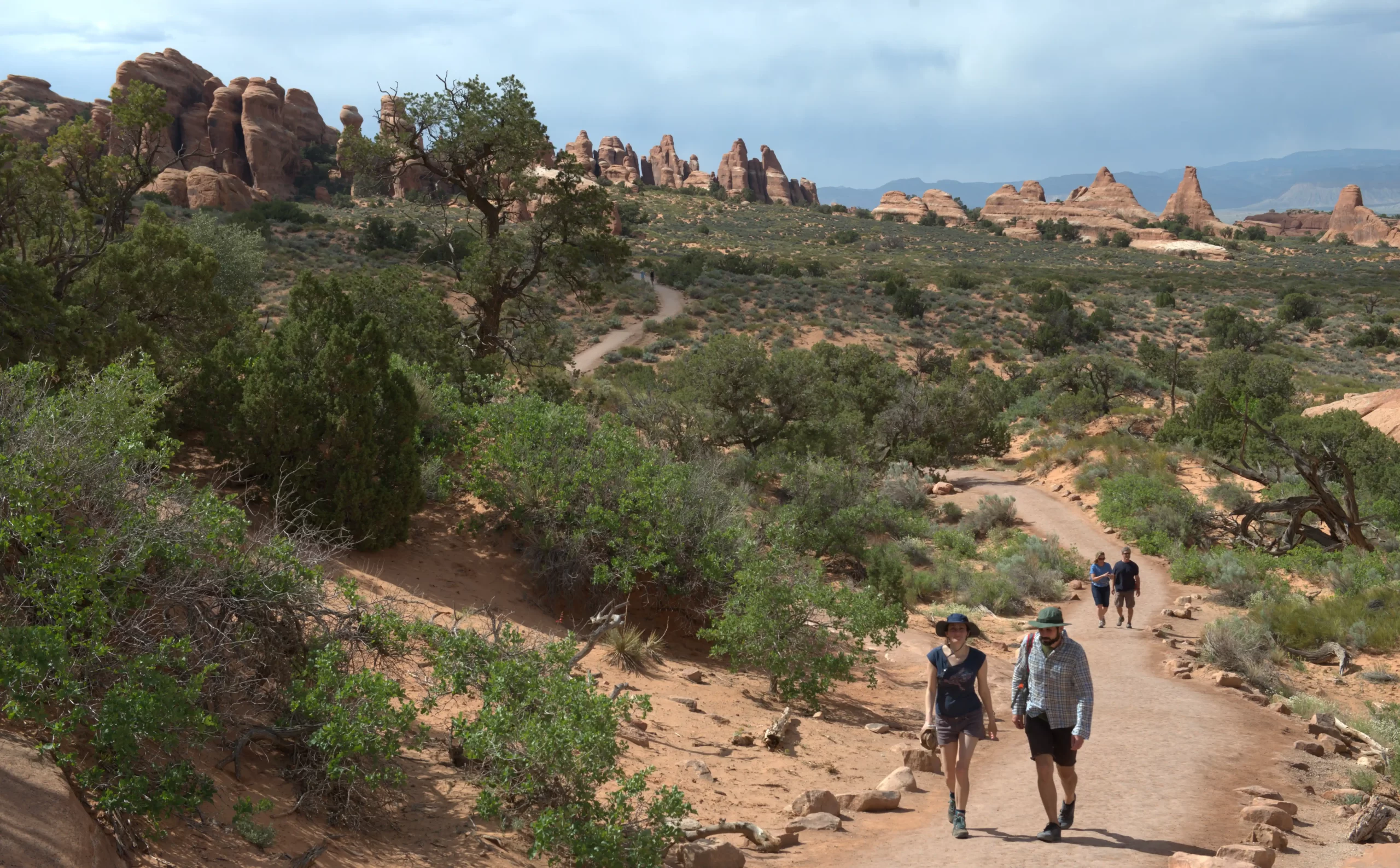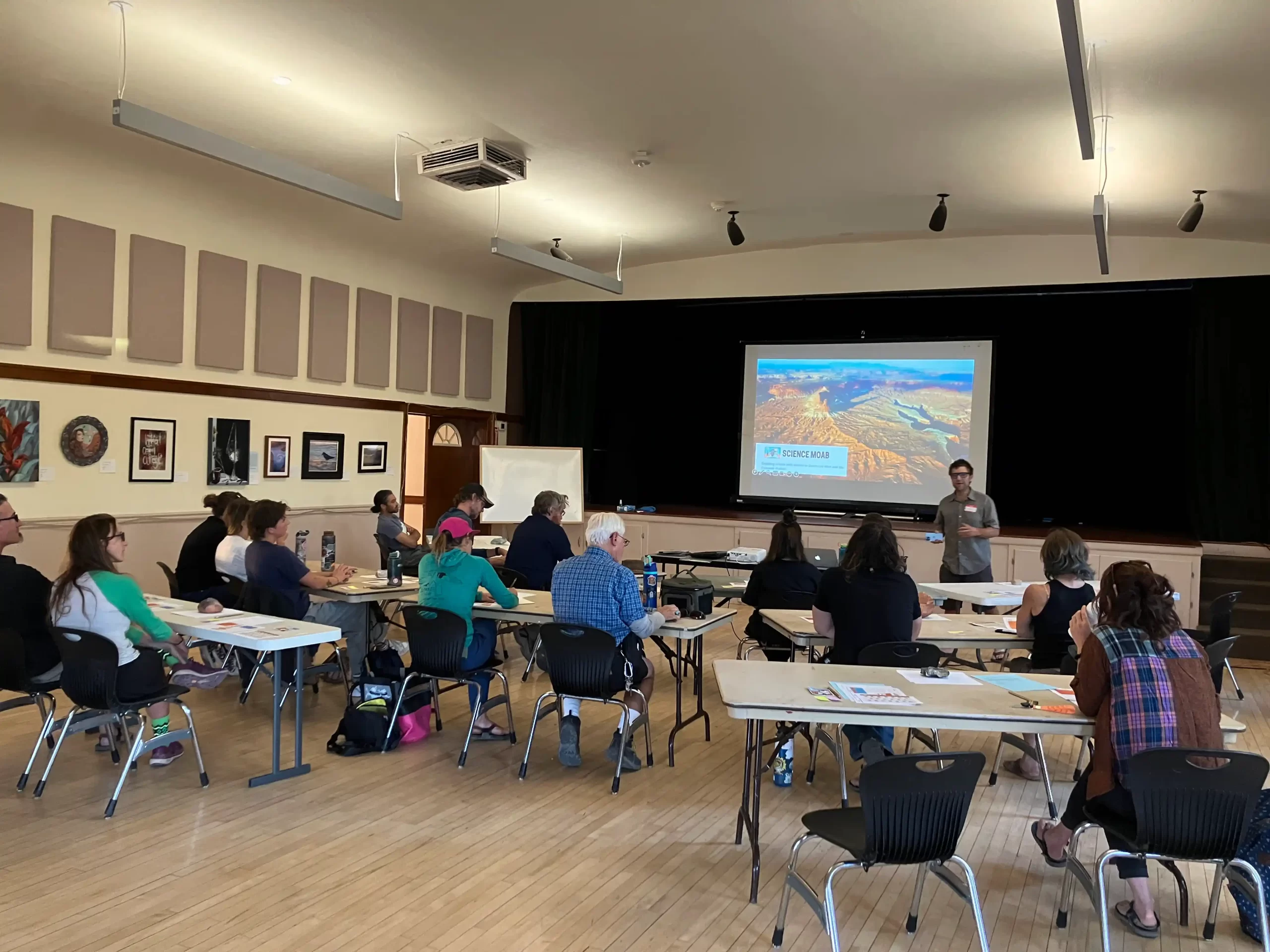Mark Beeson bought his first piece of historic ephemera when he was in the 7th grade. A classmate brought in a small leather-bound notebook, probably made in the 1930s or 40s, printed with the words, “Courtesy of Cooper-Martin.”
The Cooper-Martin Store was one of the first in Moab, founded in the early 20th century—the building still stands on Main Street today, with a large painted sign above the door bearing the name. Beeson purchased the book for ten cents.
That was the beginning of a lifelong hobby of researching local history and collecting documents and objects from previous eras. Beeson recently arranged his collection in an apt location: a turn-of-the-century cabin built by early European settlers in Moab.
Moab local Terrence Thompson recently bought the property where the cabin sits and plans to develop workforce housing on part of the lot. While some Moabites were concerned the cabin could be demolished, Beeson said Thompson plans to leave it intact. Its history will be celebrated and enriched through its new role as an informal museum with Beeson’s collection.
Beeson hopes people will visit and deepen their understanding of Moab’s past through the displays.

“My idea is for families to come by if they want to find out about pioneer families,” he said. Beeson can be reached through Facebook to arrange a tour.
The walls inside the cabin are covered with displays of photographs and materials from early Moab, organized by topic. Relics like receipts and advertisements from old Moab businesses are clustered: the Cooper-Martin store; the Moab Garage Company, which was once a car repair garage but is now a coffee shop and bar of the same name; the Moab Co-op store; and Hammond’s, which was where the Trailhead Restaurant is now.
Another display contains envelopes postmarked from long-gone towns—Elgin, Westwater, Richardson—and from pre-1896, before Utah became a state. Those are postmarked with “Territory of Utah.”
There are historic objects as well: a stringless banjo that belonged to Angus Stocks, an early Moabite to whom Beeson is related, and the green uniform jacket that early Moabite Howard Balsley wore when he worked as a ranger for the U.S. Forest Service. Outside, antique blacksmithing tools and leather working materials are housed in sheds.
Beeson has been collecting this stuff for decades. He doesn’t have any formal education as a historian—he says his history habit is just a hobby—but he has spent a lot of time looking through dusty boxes of papers and seeking out details to fill holes in stories. Part of the appeal is that a lot of the local history involves his own family: he’s a sixth-generation Moabite.
When he was a kid, he remembers hanging around the old museum and looking through collections. (At the time, Moab’s museum was called the Southeastern Utah Society of Arts and Science and was housed in a different building.) Later he spent some time working as a field assistant for archaeologists; he also ran an antique store, in a church-like building used as a set for an old movie on north Highway 191. When friends and acquaintances are downsizing keepsakes left from parents and grandparents, they’ll often call him to ask if he’d like to take a look.
“A lot of this collection is from families who let me display their stuff,” Beeson said.
Beeson uses signatures, documents, and photographs to piece together timelines and stories. He sometimes gets stumped, he said, because of a tradition of naming first sons after their fathers—it can be hard to determine which generation a document or artifact belongs to with only a name for a clue.
“I’m the third Mark Beeson,” Beeson said by way of example. He’s come across at least five people in Moab pioneer history named Sid Pace.
He keeps an eye out for specific items. For example, he’d like to find a photograph of “the old rock house” that used to sit at the corner of Mill Creek Drive and Murphy Lane—he can remember it still standing when he was a kid. It’s gone now. His “holy grail” that he’s still looking for, he said, is an original note printed by the Cooper-Martin store when it opened a bank branch in 1916 and began printing its own bills. Beeson has seen copies of them—he said they’re intricately decorated, and he’d love to have one in his collection.
A wealth of items, Beeson said, came from the Balsley family. Howard Balsley was Grand County’s Clerk Auditor for 13 years in the first half of the 20th century and had a habit of saving documents. Beeson asked Balsley’s grandson, Tom Balsley, if there were any documents of interest, and if he could have a look. Tom Balsley dropped off a box of papers, which Beeson began to sort through.
“Next thing I know I’m hoopin’ and hollerin’,” Beeson said—the box contained items he’d been looking for.
Moab Museum staff have turned to Beeson for help in understanding the context and content of some of the museum’s items. Tara Baresh is the museum’s curator and collections manager, and she said Beeson’s depth of knowledge has been very valuable as the institution has updated both its exhibits and its approach to storing, cataloging, and presenting its collections.
“It’s helpful to have [Beeson] because when he sits down, he recognizes a lot of people in the photos,” Baresh said. Beeson is also grateful to the museum for helping him to interpret items he’s found.
Beeson started inviting visitors to the cabin this spring—so far people have found out about it mostly through word-of-mouth. He enjoys both sharing his knowledge of local history and learning what other people remember or have heard or seen.
“Yearbooks are great,” Beeson said. “It gets people talking.” He has a set of yearbooks from Grand County High School spanning 1948-1960. Longtime Moabites who come in and page through are reminded of classmates and stories from their own or their families’ pasts. “That’s the neat thing about it,” he said. “They go back. If someone handed me a ‘76 yearbook, I’d do the same thing.”
There are also keepsakes from Woody’s Tavern, a favorite spot of Beeson’s: he grew up across the street from Woody Woodward, who opened the tavern. Most of the displays, though, cover roughly the time of the earliest European-American settlers in the Moab Valley up to the uranium boom of the 1950s. That’s the period that interests Beeson most. He sees those pioneers as the hard-working, creative predecessors that paved the way for today’s generation.
“What interests me is that we all use these people’s blood, sweat and tears. It wasn’t easy to live here—or even to get here,” Beeson said. Before transportation by road or by rail, travelers had to traverse rough terrain and cross the Colorado River by fording or ferrying to reach the Moab Valley.
Beeson chafes when he hears early ranchers and miners characterized as exploiting the landscape. They worked hard to get by and to build up what we have today, he says—including the old mining and ranching roads now used to access outdoor recreation areas or as biking, hiking or jeeping trails.
“I think they deserve respect, and that’s why I save their stuff,” Beeson said. “It’s like a big ‘thank-you’ to them.”
Beeson plans to soon expand activities at the cabin, hosting living history demonstrations of handicrafts and skills like blacksmithing, flint knapping, canning vegetables and butchering farm animals. Anyone interested in sharing such skills can contact Beeson through Facebook messenger. He’s also considering setting up an outdoor projector to display 8 mm slides and movies, both from his own collection and any that visitors might like to share. There is also a small library of history books that visitors can borrow; or if people are looking for specific documents, they can browse through items not on display.
Beeson hopes more people will get interested in paying the cabin a visit, and imagines that the youngest generation of Moab’s legacy families in particular might enjoy recognizing names of their own ancestors and learning new things about their lives. Or, if transplanted Moabites are back in town for a wedding, funeral, or reunion, they might stop by the museum to soak up some memories.
“People are always connected,” Beeson said—if someone reads something about their hometown, it strikes a chord, even if they haven’t been there for decades. But, he added, “It seems like people are losing their roots and connections.” Beeson’s collection is a testament to the connection between the past and today.





